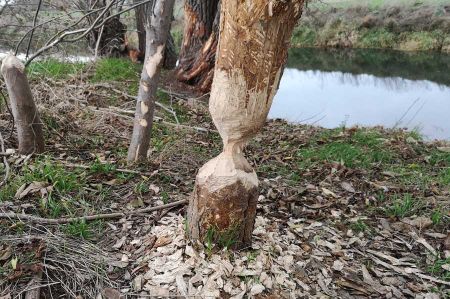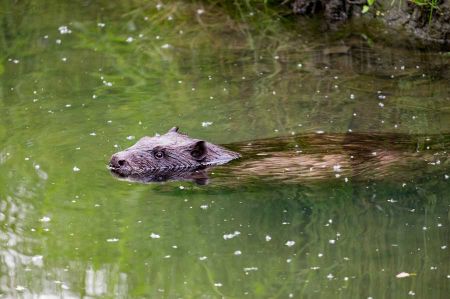Beavers in the Unstrut river near Wendelstein Castle
- Written by Portal Editor
On the way for a walk along the Unstrut river from Roßleben to Memleben, we came across gnaw marks on the bank that only beavers can create - gnaw marks on the willows and alders and corresponding shaving-like wooden pieces on the bottom.
Although the local beaver had taken on a little too much, because this specimen could not fell the mighty alder.
It is precisely the felling of trees that has put the beaver in such a bad light within people's habitats: Beavers damage forestry. Although they mostly use younger trees, some mature trees are actually gnawed or even felled. If the tree species are financially interesting from a forestry point of view, the damage can be considerable, according to forestry in the past. Just as if the monocultures of the same forestry had not caused much greater damage.
The first beaver populations are settling again

The damming of bodies of water leads to flooding at the edge of the water. Spruce monocultures are sensitive to waterlogging and can therefore die. Dams built by beavers near the street or on underpasses can lead to undercutting.
Sometimes caves are built in flood protection dikes. In the event of a flood, these lead to unstable dikes and, in the worst case, to dike breaches. The problem can be avoided by taking suitable measures at the endangered areas.
In the summer months, the beaver also uses field crops (sugar beet, corn) near the water. Eating damage in fields has been reported several times.
Really such weighty reasons to almost completely exterminate beavers?

Today the various organizations take care of the repopulation by the beaver, so the NABU works out measures to improve the habitat and to minimize hazards. Waterfront residents and managers, hunters, anglers as well as farmers and foresters are shown proven ways to live and work with the beaver without conflict.
The beaver also reached the Unstrut-Hainich district in tentative steps. In all of Germany there are said to have been over 100,000 animals until they were almost exterminated by humans on the hunt for fur, meat and the beaver horn used as a remedy.
Webbed feet and a leathery tail - a perfect aquatic animal
Beavers colonize rivers of all sizes, from first-order rivers to drainage ditches. It can also take on all forms of still waters, from ponds or oxbow lakes to lakes. If there are only inadequate habitats available to it, the beaver is sometimes very adaptable and also settles in unusual places, for example in the middle of towns or directly on highways, where woody plantings are often the most important source of food.
Housing boiler, beaver castle and dam - typical beaver buildings
The beaver is a pure herbivore. It prefers herbs, shrubs, water plants and deciduous trees such as aspens, alders and poplars. From the trees it felled it consumed the twigs, the astringent and the leaves. However, it is actually a plant-based omnivore, it also feeds on grasses and reeds.
The beaver is crepuscular and nocturnal. When cutting down it uses an "hourglass technique"; the wood is gnawed in the shape of an hourglass until the tree falls. Depending on the hardness of the wood, a beaver can fell a tree up to 50 centimetres thick in one night.
The beaver structures consist of residential buildings and beaver dams, some of which are dug into the ground close to the shore, some of which are built from building material that has been dragged along: loose branches, twigs, stones, mud and trees felled by the beaver up to a trunk diameter of 80 centimetres.
Beavers are known for their dams, which they use to dam streams and even create artificial ponds. The dam primarily helps to ensure a water level above the entrance to the residential building of as much as 60 centimetres and a secure water area around the castle. Beaver dams in flowing waters are threatened with being swept away during heavy rainfall. Beavers can open their dam to allow floods to drain more quickly and thus protect their dam. In this way they regulate the water level of their water area and thus enable more sensitive aquatic plants to thrive in the pond, which can serve as food for the beaver. Beaver dams require constant expenditure, especially in rivers.
Please read as well:
By Bike to the healthy sources of Bad Bibra
With e-bike to 12 Apostel Bridge near Bad Bibra
